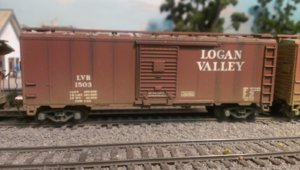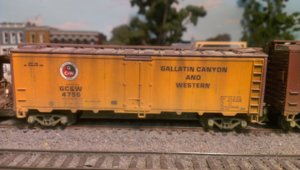IronBeltKen
Lazy Daydreamer
A few years ago I spent ~6 weeks weathering all my locomotives so they would look "real" when they were photographed. After my most recent op session, it dawned on me that having weathered locos coupled to un-weathered rolling stock just didn't work. So in early May, I decided to tackle the chore of weathering all my active freight cars. 'Active' cars are the ones that I can spot at visible destinations on the layout - I don't run bridge traffic, so anything only usable in pass-thru mode hardly ever gets takin out of their box. This brought the number of cars to ~200, a number which seemed like something I could actually accomplish within a few months.
This thread is mostly a recap of my experiences and lessons learned during the weathering project. Originally I was going to make it more like a blog and post a little bit to it each day, but I soon realized that would be impractical: I needed to be hyper-focused if I wanted to finish this thing within a reasonable time frame, and spending time to compose forum entries would use up too much of my scarce free time (I'm a slow typist). However, I did manage to capture a few before-and-after image pairs with my cellphone camera.
Defining "generic"
I call my wethering work "generic" because it isn't too detailed, i.e., nothing remotely close to what used to appear in photos on the now-defunct ModelTrainsWeathered.org web site. Just a few light layers of airbrushing the body and painting the wheels & truck sideframes with flat colors ranging from light grey to rusty brown, to eliminate the plastic sheen and fresh-from-the-box toylike appearance of each freight car. I can always go back later to add more detailed grunge spots to individual cars.
Whenever possible, I looked at photos of the type of car I wished to emulate to get a general idea of how they looked. I also tried to stay era-specific, i.e., cars painted for recently-merged roads [in 1970] such as Bulrlington Northern and Penn Central would not be as dirty as cars that had been painted in the 1950's or early '60's. As part of my strategy to avoid having any two cars of the same type look identically weathered, I printed a hardcopy list of all the cars sorted by road number in ascending order, independent of roadname. This would usually [though not always] add a sort of random variety to the car types.
My project got off to a late start because I lacked sufficient supplies of paint and airbrush paraphernalia; I wanted to have everything on hand so I wouldn't run short in the middle of a spraying session. As soon as I had everything and established a repeatable process of prepping, spraying, and [thoroughly] cleaning my airbrush, I was able to finish 1-2 cars per weekday evening and 15-20 cars over a weekend.
Here is a before/after pair of images of a car from one of my earliest runs, an Athearn coal hopper. My goal here was to decrease the stark contrast between the white lettering and the black body. I learned that this was not an optimal location to shoot photos because of reflected glare of the flourescent bulbs, plus the fact that my cellphone camera doesn't capture the finer nuances of color and texture that are visible to a human eye:


After this I started making other hopper cars somewhat dirtier and used more brown for rust effects.
This thread is mostly a recap of my experiences and lessons learned during the weathering project. Originally I was going to make it more like a blog and post a little bit to it each day, but I soon realized that would be impractical: I needed to be hyper-focused if I wanted to finish this thing within a reasonable time frame, and spending time to compose forum entries would use up too much of my scarce free time (I'm a slow typist). However, I did manage to capture a few before-and-after image pairs with my cellphone camera.
Defining "generic"
I call my wethering work "generic" because it isn't too detailed, i.e., nothing remotely close to what used to appear in photos on the now-defunct ModelTrainsWeathered.org web site. Just a few light layers of airbrushing the body and painting the wheels & truck sideframes with flat colors ranging from light grey to rusty brown, to eliminate the plastic sheen and fresh-from-the-box toylike appearance of each freight car. I can always go back later to add more detailed grunge spots to individual cars.
Whenever possible, I looked at photos of the type of car I wished to emulate to get a general idea of how they looked. I also tried to stay era-specific, i.e., cars painted for recently-merged roads [in 1970] such as Bulrlington Northern and Penn Central would not be as dirty as cars that had been painted in the 1950's or early '60's. As part of my strategy to avoid having any two cars of the same type look identically weathered, I printed a hardcopy list of all the cars sorted by road number in ascending order, independent of roadname. This would usually [though not always] add a sort of random variety to the car types.
My project got off to a late start because I lacked sufficient supplies of paint and airbrush paraphernalia; I wanted to have everything on hand so I wouldn't run short in the middle of a spraying session. As soon as I had everything and established a repeatable process of prepping, spraying, and [thoroughly] cleaning my airbrush, I was able to finish 1-2 cars per weekday evening and 15-20 cars over a weekend.
Here is a before/after pair of images of a car from one of my earliest runs, an Athearn coal hopper. My goal here was to decrease the stark contrast between the white lettering and the black body. I learned that this was not an optimal location to shoot photos because of reflected glare of the flourescent bulbs, plus the fact that my cellphone camera doesn't capture the finer nuances of color and texture that are visible to a human eye:
After this I started making other hopper cars somewhat dirtier and used more brown for rust effects.
Last edited:



